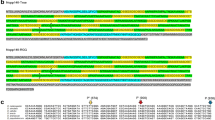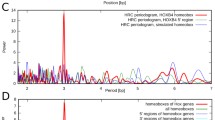Abstract
The per locus has a fundamental involvement in the expression of biological rhythms in Drosophila. Mutations at this locus can shorten, lengthen or eliminate a variety of rhythmic activities that range from circadian behaviours, exemplified by eclosion and locomotor activities1,2, to short-period behaviour such as the 55-s rhythm of courtship song3. DNA from the per locus has been cloned4–7, and we have used P-element-mediated DNA transformation to establish that a 7.1-kilobase (kb) HindIII fragment contains a functional copy of the gene. This transforming DNA contains a single transcription unit which gives rise to a 4.5-kb poly(A)+ RNA5. Here we report the results of a search for sequences homologous to the per locus DNA in the genomic DNA of several species of vertebrates. An unusual, tandemly repeated sequence forming a portion of the 4.5-kb per transcript is homologous to DNA in chicken, mouse and man. Cloned DNAs from the mouse and Drosophila are related by long, uninterrupted tandem repetitions of the sequence ACNGGN. At the per locus, these tandem repeats are predicted to code for poly(Thr-Gly) tracts up to 48 amino acids long. These repeated sequences are also transcribed in the mouse. Several long tracts of poIy(Thr-Gly) appear to be encoded by DNA cloned from the mouse.
Similar content being viewed by others
References
Konopka, R. & Benzer, S. Proc. natn. Acad. Sci. U.S.A. 68, 2112–2116 (1971).
Young, M. W. & Judd, B. H. Genetics 88, 723–742 (1978).
Kyriacou, C. P. & Hall, J. C. Proc. natn. Acad. Sci. U.S.A. 77, 6729–6733 (1980).
Bargiello, T. A. & Young, M. W. Proc. natn. Acad. Sci. U.S.A. 81, 2142–2146 (1984).
Bargiello, T. A., Jackson, F. R. & Young, M. W. Nature 312, 752–754 (1984).
Reddy, P. et al. Cell 38, 701–710 (1984).
Zehring, W. A. et al. Cell 39, 369–376 (1984).
Mount, S. M. Nucleic Acids Res. 10, 459–472 (1982).
Dame, J. B. et al. Science 225, 593–599 (1984).
Godson, G. N., Ellis, J., Svec, P., Schlesinger, D. H. & Nussenzweig, V. Nature 305, 29–33 (1983).
Ravetch, J. V., Kochan, J. & Perkins, M. Science 227, 1593–1597 (1985).
Kurjan, J. & Herskowitz, I. Cell 30, 933–943 (1982).
Dworkin-Rastl, E., Shrutkowski, A. & Dworkin, M. B. Cell 39, 321–325 (1984).
Tartof, K. Cold Spring Harb. Symp. quant. Biol. 38, 491–500 (1974).
Smith, G. P. Cold Spring Harb. Symp. quant. Biol. 38, 507–513 (1974).
Dover, G. Nature 299, 111–117 (1982).
Bourdon, M. A., Oldberg, A., Pierschbacher, M. & Ruoslahti, E. Proc. natn. Acad. Sci. U.S.A. 82, 1321–1325 (1985).
Dale, R. M. K., McClure, B. A. & Houchins, J. P. Plasmid 13, 31–40 (1985).
Messing, J. Meth. Enzym. 101, 20–78 (1983).
Biggin, M. D., Gibson, T. J. & Hong, G. F. Proc. natn. Acad. Sci. U.S.A. 80, 3963–3965 (1983).
Author information
Authors and Affiliations
Rights and permissions
About this article
Cite this article
Shin, HS., Bargiello, T., Clark, B. et al. An unusual coding sequence from a Drosophila clock gene is conserved in vertebrates. Nature 317, 445–448 (1985). https://doi.org/10.1038/317445a0
Received:
Accepted:
Issue Date:
DOI: https://doi.org/10.1038/317445a0
- Springer Nature Limited
This article is cited by
-
MicroRNAs regulate gene plasticity during cold shock in zebrafish larvae
BMC Genomics (2016)
-
No evidence of genetic benefits from extra-pair fertilisations in female sand martins (Riparia riparia)
Journal of Ornithology (2007)
-
Genetic mating system and timing of extra-pair fertilizations in the Kentish plover
Behavioral Ecology and Sociobiology (2004)
-
Genetic similarity between mates and extra-pair parentage in three species of shorebirds
Nature (2002)
-
Functional correlation between the nuclear localization of Fht1p and its flocculation and heat tolerance activities in budding yeastSaccharomyces cerevisiae
Journal of Biomedical Science (2001)





